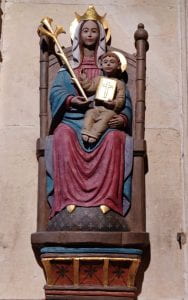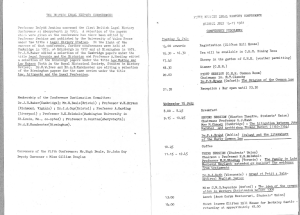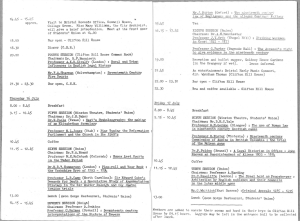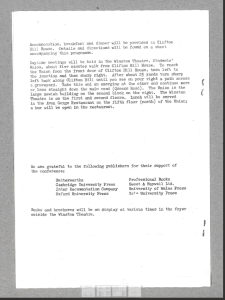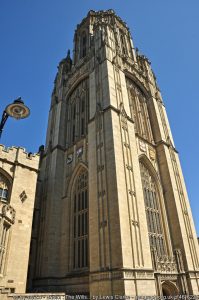
The Law School and the Centre for Law and History Research hosted the 26th British Legal History Conference from 3rd to 6th July 2024. The conference organisers were Gwen Seabourne and Joanna McCunn. Read on to see some of their reflections on the experience.
GS: Now that we have had a bit of time to recover, and the dust has settled, it seems like a good chance to think about our time preparing for, and hosting, the BLHC. I came away feeling happy about it all, and glad that we did it. What about you?
JM: I’m really glad we did it too! There was definitely a lot of work involved behind the scenes – not just by us but by lots of our colleagues too. But it felt like it all paid off as soon as the conference delegates arrived and started enjoying the events we had planned for them. I was especially glad that we were able to show off some Bristolian highlights, even if the weather didn’t always co-operate…
GS: It felt to me like a good time to do this, both in personal terms, and also in terms of where legal history is as a discipline at the moment.
The personal aspect is that putting this thing on is an absolutely massive task. Fellow medieval legal historians (a really huge demographic …) will know what I mean when I say that hosting the BLHC is a little bit like having the general eyre visit your town (only without the hangings). The size of the undertaking means that, at earlier points in my career, when I ran the legal history unit at Bristol single-handed, and there were nothing like as many legal historians and legal history-friendly academics in the Law School as we now have, it would have been far too much to take on. Now, though, we are in a much stronger position, with several colleagues working in the area, our own research centre, and even a legal historian as Head of School. And, of course, it was great to do this with you. Thank goodness we get on well, trust each other’s instincts and were generally ‘on the same page’ in terms of what we wanted to do with the conference. Imagine if we’d had ‘artistic differences’ …!
JM: Haha, yes, I’m very glad that neither of us turned out to be a conference diva! And that we were able to keep a sense of humour about it all.
GS: The bigger picture, for me at least, was that legal history is in an interesting place generally. It is something that attracts scholars from a number of different academic backgrounds, and, although its ‘centre of gravity’ remains in law schools, it does feel as if it is opening up to, and welcoming the perspectives of, social and economic historians, literary scholars and others. I have always been keen on pushing the inter-disciplinary aspect of legal history, and this was a great chance to do that.
JM: This was something that we thought about when we planned the conference theme, wasn’t it? We were interested in hearing about history’s legal ‘insiders’, powerful actors who could use the law to their advantage, and ‘outsiders’, people who have been marginalised by the law or sought to resist it.
But we also wanted to nod to questions around ‘insiders’ and ‘outsiders’ to legal history as a discipline. I’ve sometimes heard people say ‘I’m not a real legal historian’, by which I think they mean that they don’t sleep with a picture of Edward Coke under their pillow! In fact, there’s been a real blossoming of all kinds of work on law and history, which has enriched the discipline enormously.
I was really proud that a third of our attendees were coming to the BLHC for the first time, and that so many people commented on how welcoming and inclusive the conference felt. We spent a lot of time thinking about how to make sure that nobody felt like an ‘outsider’ when they arrived.
GS: Not going to comment on the Edward Coke under the pillow thing. Perfectly normal… But yes, it was important to make people feel as welcome as possible. Not being a huge extrovert, I am certainly well aware that it can be hard to turn up at a conference not knowing anyone, and feeling that everyone else knows each other. It took me quite some time to join in conversations outside the academic sessions at conferences, and it would have been very easy to be discouraged. So I was really glad to see that people had felt as if they were amongst friends, and able to talk to others with similar interests.
JM: Our speakers really took the ‘insiders and outsiders’ theme and ran with it – I think we were both delighted that it received such an enthusiastic response! There were papers about the ‘insider’ or ‘outsider’ status of colonial officials, gender non-conforming people, legal academics, parish officers, ‘lawless’ women, Black Bristolians, murderous sailors, Roman lawyers, travelling merchants, judges, children, refugees, widows – even the Devil himself. And it was very interesting that so many of the papers problematised or complicated the idea of an obvious insider/outsider divide.
GS: I really enjoyed the lectures and papers I heard. We couldn’t get to everything, but I made a point of stepping outside my medieval British comfort zone and going to hear about things from different eras and different places. It is a wonderful chance to appreciate new approaches, new theories, new discoveries, and just to keep learning. It is probably the case that, at the start of my career, I was most concerned with my own presentations – making sure I was coherent, to time, and did not dry up in the face of questions. Now, though, I get just as much from hearing what other people have been up to, taking an interest in their work, and seeing how different scholars’ research connects or contrasts.
There is a lot of great work coming through, both from established legal historians, and also from those at the start of their careers. There was certainly strong competition for the prize for the best paper by a postgraduate student, which was, in the end, won by Rhiannon Ogden-Jones for her innovative work on national parks. We were really glad that the Sir Anthony Hart Doctoral Paper Prize was sponsored (and expertly run) by the Irish Legal History Society – big thanks to them.
And it wasn’t just us that came away buzzing at the excellence of the work on display – people certainly seemed to get a lot out of the conference intellectually as well, didn’t they?
JM: Yes, our attendees were so thoughtful and generous with their comments in the Q&A sessions, and those conversations kept going over lunch and coffee every day. This is why it’s so valuable to attend in-person conferences – they’re a fantastic opportunity to meet new people, find out more about their work, and make connections as you chat between sessions. Thanks go to our caterers as well, by the way, for making sure that we were well-fed and well-caffeinated throughout the four days!
GS: Finally, I suppose one thing I really want to happen now is for the general good will and energy of our attendees to continue in the future. The BLHC only comes around every two years, and it would be a shame for the momentum to dip and diminish. There is work to be done to keep people in touch with each other and with the wider ‘legal history community’. There are a lot of initiatives out there – research centres at a number of universities, as well as our own Centre for Law and History Research and also the Bristol-Exeter-Cardiff collaboration, Law and History Network (fine online legal history seminars provided free of charge and in a friendly atmosphere, thank you for asking…) and we hope that these will go some way to bridging the gap between BLHCs.
JM: Online seminars are a great way to keep in regular contact with the legal history community – and they’re a lot less labour-intensive to run than a big conference! It’s been great to work with our friends in Exeter and Cardiff, and we’re looking forward to sharing our conference experiences with the wonderful legal historians in Nottingham as we pass the BLHC baton onto them.
For now, I’ve left the conference feeling inspired and excited about digging into more legal history during my year of research leave. At least once I’ve caught up on my sleep!
GS: Not jealous of your research leave year at all … But seriously, looking forward to hearing what you come up with. And all the best to Sarah and Will at Nottingham as they begin the process of organising the next BLHC, for 2026.
Gwen Seabourne and Joanna McCunn




